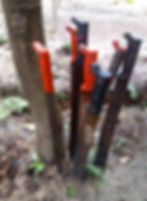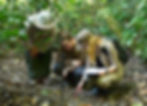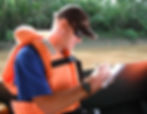
Forest Guardians Team
Experience life at the sharp end of forest
conservation in Amazonian Peru
Team Objectives
To effectively monitor and protect state-led, community-led, and private reserves in Amazonian Peru requires a lot of walking, careful observation, clear communication, and data collection within and around the margins of these conservation areas, especially with respect to the state of indicator or keystone species of conservation importance and the presence of anthropomorphic threats, mainly activities undertaken by recent settlers who may not know the land-use status of forest and unscrupulous resource extractors that travel great distances to obtain a particular resource without much heed for who owns or manages the forest. Each of the reserves we work with has its own list of priority species that need monitoring, from trees to mammals to birds, the annual status of which is used to assess the degree of conservation success or failure. The principal threats to wild nature include illegal timber extraction, bushmeat hunting, agricultural encroachment, new trails and roads, the presence of domestic animals, the presence of diseased wild animals, etc. Our volunteer forest rangers assist trained rangers and other experts with numerous activities during long days in and around forest reserves, including: wildlife data collection, GPS tracking of legal and illegal trail networks, placing and maintaining signage around the periphery of reserves, locating illegally-extracted timber trees, collecting photographic evidence of illegal activities when found, communicating illegal activities to the relevant authorities (such as Regentes registered with Peru's Forest Service-SERFOR) and sometimes even confiscating equipment from illegal extractors (though only in the presence of the authorities), and so forth. Having received the relevant training, which takes a minimum of 1 week, a significant amount of time is spent travelling to and establishing satellite camps near the periphery of reserves, and monitoring areas around each of these camps. During the camping phase, team members carry in all their supplies, sleep in private tents or Hennessy-type hammocks, and collaborate with food preparation. A knowledge of Spanish and a high level of physical fitness is highly recommended in order to assist this project. Intensive Spanish language classes can be provided by Fauna Forever partners in Puerto Maldonado or Cusco for an extra fee (contact us for a quote).
%20s.jpg)
A sign-post located at the entry to the Tambopata National Reserve, near the Tambopata River. Photo: Chris Kirkby

A volunteer ranger, collecting GPS data
in a small river. Photo: Fauna Forever
Methods Used and Skills Taught
The methods, techniques, and skills that our volunteer forest rangers actively learn in this team, under the leadership and supervision of the forest rangers, include: (1) Transect surveys of mammals, birds, and trees (including track identification); (2) Use of handheld GPS equipment for accurate geolocation; (3) Map reading and satellite image interpretation; (4) Geographic Information Systems (GIS) including Spatial Monitoring and Reporting Tool (SMART); (5) Photography; (6) Use of communication equipment such as walkie-talkies and SPOT satellite devices; (7) Camp set up and maintenance; and (8) Basic survival skills for rainforest habitats.

Two pieces of vital equipment for every ranger, a machete and a walkie-talkie.
Photo: Chris Kirkby

Planning a forest ranger trip, using printed satellite imagery. Photo: Patrick Campbell
A Typical Day
After the initial 7-10 day training period, which is usually undertaken at one or other of the main research centres or lodges we use for training purposes, the team will plan a ranger patrol covering a period of 2-5 nights and a walking route of 5-30 km. Having checked and fixed all equipment required for the patrol, packed sufficient food, water, and other supplies (including water purification tablets), and informed head-office of the planned patrol route, duration, and communication times, the team will head off by foot or in one of the boats to the starting point of the patrol. The route from then on is constantly tracked by one of the handheld GPS devices, and the standard protocol taught in the training period is followed until the team reaches the first campsite, at which point each team member will undertake a specific set of tasks to ensure the camp is up and working as quickly as possible. This includes locating a good water source, firewood, and erecting tents, hammocks, and work areas. During patrol periods to and from campsites, all team members will communicate about and take data on the presence of conservation priority species and the direct signs of threats. On detecting a priority species, either visually, by sound, or via observing a track (footprint) in the mud or sandbar of a stream, up to 5 mins is spent collecting the necessary information, including GPS location. On detecting a threat sign (e.g. human footprint, machete cuts on vegetation, an unexpected trail, a felled tree, a shotgun report, etc.) up to 10 mins may be spent collecting preliminary information, before a decision is made whether to follow up the investigation or not. In the case of an unexpected trail, this will usually be followed and tracked with a GPS to determine if it leads to a felled tree or similar. If a felled tree is found, it will be identified, its girth will be measured to determine the age of the tree, the volume of removed timber estimated, the date of felling estimated, and its location logged in the GPS. If an encounter with illegal extractors or other trespassers is predicted, then all team members will follow the human encounter protocol. In this case, the lead or senior ranger, or Regente if he/she is present on the patrol, is responsible for initiating communication and for ascertaining why the person or persons are located within the reserve. For health and safety reasons the team may decide not to initiate contact at this time and rather communicate with head office and potentially return with more people, including a Regente or member of the local ecological police force based in Puerto Maldonado. Patrol days tend to be very long and tiring, and environmental conditions can be difficult and uncomfortable, especially if it rains a lot or a cold Friaje front arrives.
A magnificent view across the rainforest from the branches of a tall Shihuahuaco (Dipteryx micrantha) tree. A good spot from which to listen for illegal extractive activities, like the sound of far off chainsaws. Video: Chris Kirkby
Recommended Reading
Books and Field Guides

Wildlife Watcher Guide
By: M. Leach

A Neotropical Companion
By: J. Kricher

Neotropical Rainforest Mammals
By: L. Emmons









